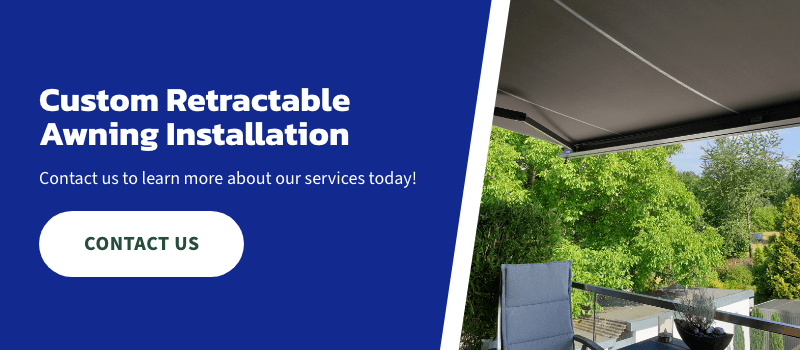
Because awnings are constantly exposed to the elements, it’s normal for them to endure occasional wear and tear and technical problems. If you experience any complications with your outdoor shade, there are many ways you can perform electric awning troubleshooting and resolve the issue with ease.
Learn about some of the most common problems with retractable awnings and the steps you can take to fix them.
Sagging
If your sunshade appears to be sagging, chances are your canopy is overextended. It’s easy to fix a sagging awning — just crank the handle in reverse until the fabric tightens and be mindful of how the material is rolling. For the best results, make sure the cloth rotates over the top of the roller tube rather than spooling underneath it.
Mechanical Problems
If your electric awning won’t retract, you’re likely experiencing complications with one of three components:
- Motor: If your motor is damaged or malfunctioning, you’ll notice retraction issues such as jerking, jamming, or constant closing. Complications of this nature are best repaired by experienced professionals who will inspect your sunshade, determine the proper parts and replace or repair the equipment.
- Tracks: If your awning sticks or comes off its tracks, try checking for debris that could be clogging the tracks and cleaning out any dirt or gunk. You can also apply additional lubricant to resolve the sticking.
- Sensors: Electric sensor failure can occur as a result of power outages or glitches. You can either operate the blind manually or call in a repair company to recalibrate, reinstall or replace your retractable sunroof.
Damaged Fabric
Another common problem with retractable awnings is damaged fabric caused by a variety of elements:
- Sun damage: If your fabric has faded due to sun damage, try sweeping it off to remove debris, then hose it down with soap to prevent future fading from occurring.
- Fungus or mold: Mold can grow on your sunshade due to water and heat exposure. To remove fungus, spray the shade with a hose and apply mildew remover. Make sure you don’t close the shade until it completely dries.
- Rips or tears: If your canopy is ripped or torn, you can use patches or special tapes to mend the gaps. You can even use a waterproof adhesive to seal the rip — just make sure to trim any threads first.
Environmental Issues
If outside influences affect the functionality of your awning, there are many ways you can resolve the problem:
- Wind: Strong winds can take a toll on your awning. To prevent wind-related breakage, retract the sunshade during inclement weather conditions and when it is not in use. You can even install an anemometer that will retract automatically in the event of high winds.
- Rain and snow: If you see rain or snow pooling on or weighing down your awning, angle the shade to prevent further accumulation or retract it completely.
- Animals and insects: When animals and insects try to make your awning a home, you must carefully remove the pest or critter and retract the sunroof when it’s not in use to prevent future nesting.

Skip the Repair – Install Your New Retractable Awning Today
For custom retractable awning installation, choose Garrety Glass. We care about our customers — that’s why we give them the quality products they need at the most affordable prices.
Contact us to learn more about our services today!